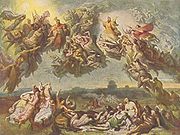
Hunnenschlacht (Liszt)
Encyclopedia

Symphonic poem
A symphonic poem or tone poem is a piece of orchestral music in a single continuous section in which the content of a poem, a story or novel, a painting, a landscape or another source is illustrated or evoked. The term was first applied by Hungarian composer Franz Liszt to his 13 works in this vein...
by Franz Liszt
Franz Liszt
Franz Liszt ; ), was a 19th-century Hungarian composer, pianist, conductor, and teacher.Liszt became renowned in Europe during the nineteenth century for his virtuosic skill as a pianist. He was said by his contemporaries to have been the most technically advanced pianist of his age...
, written in 1857 after a painting of the same name by Wilhelm von Kaulbach
Wilhelm von Kaulbach
Wilhelm von Kaulbach was a German painter, noted mainly as a muralist, but also as a book illustrator. His murals decorate buildings in Munich.-Education:...
.
The painting depicts the battle of the Catalaunian Fields
Battle of Chalons
The Battle of the Catalaunian Plains , also called the Battle of Châlons sur Marne, took place in AD 451 between a coalition led by the Visigothic king Theodoric I and the Roman general Flavius Aëtius, against the Huns and their allies commanded by their leader Attila...
in 451 AD, where the Hun
Huns
The Huns were a group of nomadic people who, appearing from east of the Volga River, migrated into Europe c. AD 370 and established the vast Hunnic Empire there. Since de Guignes linked them with the Xiongnu, who had been northern neighbours of China 300 years prior to the emergence of the Huns,...
armies led by Attila
Attila the Hun
Attila , more frequently referred to as Attila the Hun, was the ruler of the Huns from 434 until his death in 453. He was leader of the Hunnic Empire, which stretched from the Ural River to the Rhine River and from the Danube River to the Baltic Sea. During his reign he was one of the most feared...
fought a savage battle against a Roman coalition
Rome
Rome is the capital of Italy and the country's largest and most populated city and comune, with over 2.7 million residents in . The city is located in the central-western portion of the Italian Peninsula, on the Tiber River within the Lazio region of Italy.Rome's history spans two and a half...
led by Roman General Flavius Aëtius
Flavius Aëtius
Flavius Aëtius , dux et patricius, was a Roman general of the closing period of the Western Roman Empire. He was an able military commander and the most influential man in the Western Roman Empire for two decades . He managed policy in regard to the attacks of barbarian peoples pressing on the Empire...
and the Visigothic king Theodoric
Theodoric I
Theodoric I sometimes called Theodorid and in Spanish, Portuguese and Italian Teodorico, was the King of the Visigoths from 418 to 451. An illegitimate son of Alaric, Theodoric is famous for defeating Attila at the Battle of the Catalaunian Plains in 451, where he was mortally wounded.-Early...
. According to legend, the battle was so ferocious that the souls of the dead warriors continued their fighting in the sky as they rose to Heaven.
The first section of the piece, marked Tempestuoso, allegro non troppo carries Liszt's instruction: "Conductors: the entire colour should be kept very dark, and all instruments must sound like ghosts." Liszt achieves much of this effect by scoring the entire string section to play with mutes, even in fortissimo passages. This section depicts an atmosphere of foreboding and suppressed rage before the battle breaks out.
The second section, Piu mosso, begins with a "Schlachtruf" (battle cry) in the horns, which is then taken up by the strings. The main battle theme is then stated, a fully formed version of material from the very opening. This entire section makes use of the so-called gypsy scale
Gypsy scale
The term Gypsy scale, refers to one of several musical scales named after their association with Gypsy music.-Hungarian Gypsy scale:...
, which Liszt frequently used in his Hungarian-themed compositions. In this section Liszt introduces an unusual effect: against the current of the raucous battle music in the rest of the orchestra, the trombones play the ancient plainchant melody "Crux fidelis". Liszt's own description of this section was of "two opposing streams of light in which the Huns and the Cross are moving."
The "Crux fidelis" theme is later taken up by the strings in a quiet, peaceful contrasting section. The music grows in intensity, eventually including an organ and offstage brass section, and it ends triumphantly.

